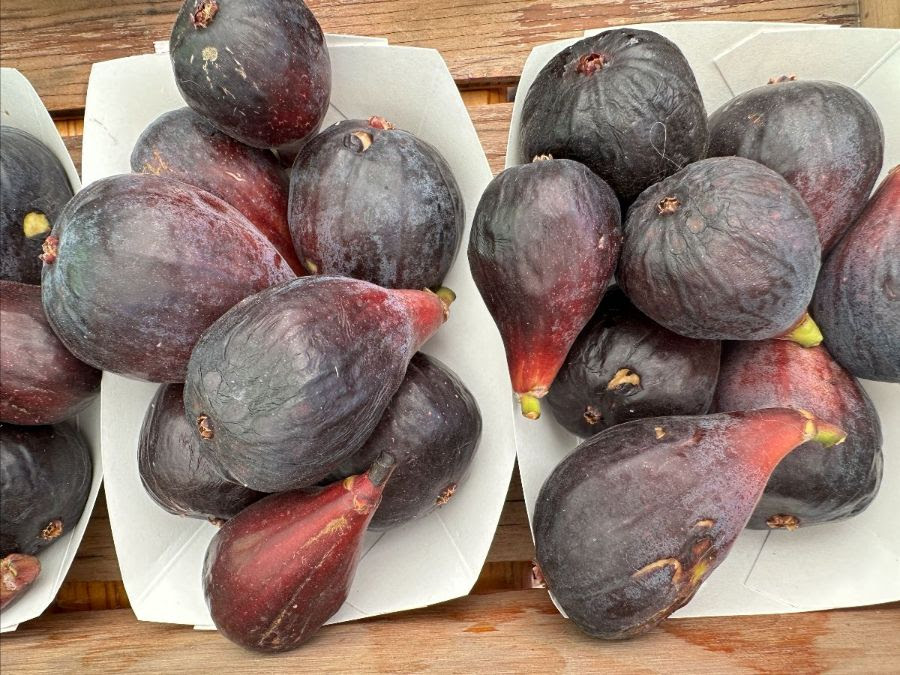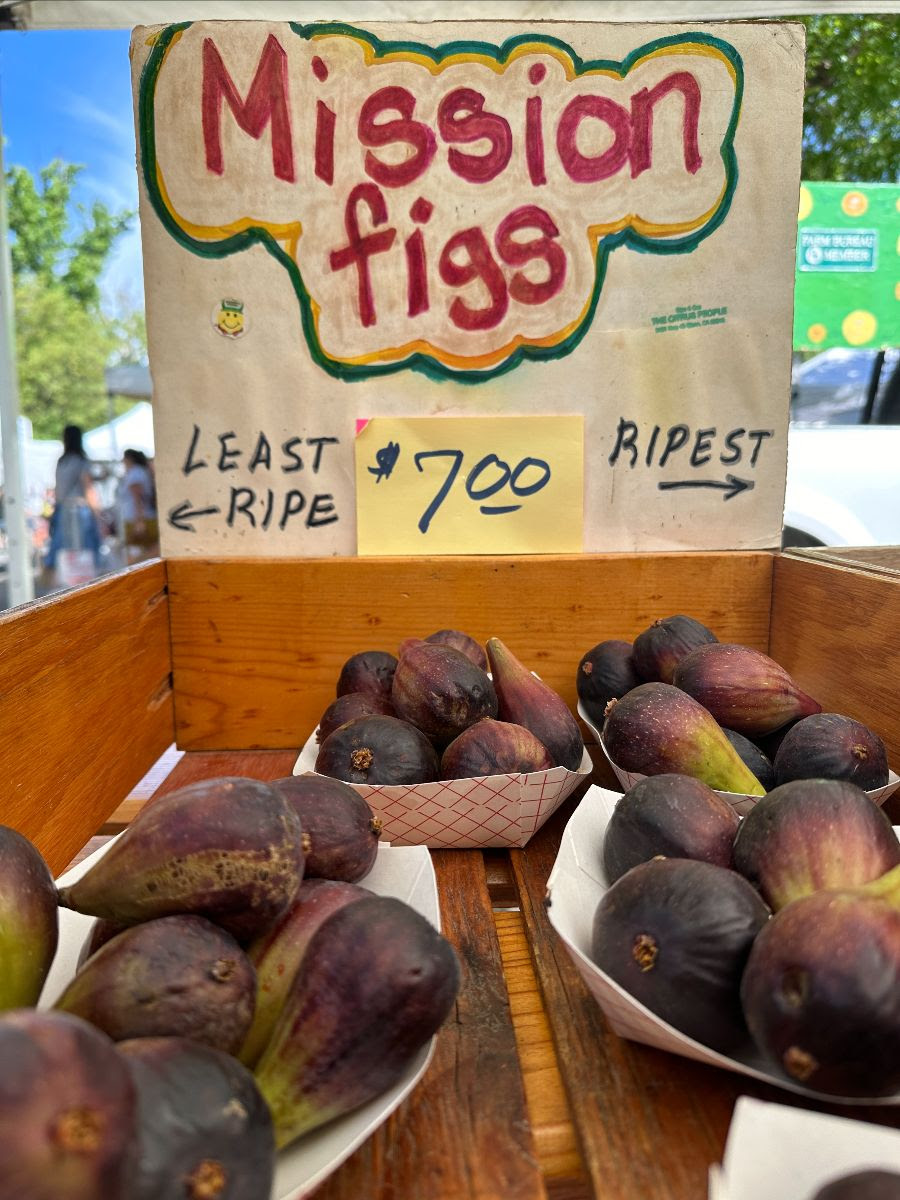Figs are here! Come on by the Chico Certified Farmer’s Market to pick up a basket (or two) of these delectable summertime treats. If you aren’t too sure about this slightly alien-looking fruit, keep reading to learn all the reasons why you should give figs a go.

The Delicious and Nutritious History of Figs
Figs, one of the oldest cultivated crops, boast a rich history and nutritious profile. Originating in Western Asia, figs have been enjoyed since at least 9400–9200 BCE, originating in the Jordan Valley. They quickly spread to the Mediterranean, becoming a staple in ancient diets. Biblical references highlight their significance, with figs symbolizing prosperity and security for the Hebrews. Even the story of Adam and Eve features a fig tree, underscoring its ancient importance.
During Greek and Roman times, figs were highly prized. They were a staple in their diets, and were so highly valued that they were even used as offerings to the gods. From here figs traveled far and wide through trade, reaching Asia first and later the New World, thanks to Spanish and Portuguese explorers in the 16th century. Today figs are cultivated globally, with varieties grown in the Mediterranean, the Middle East, and California.
Nutritionally, figs are a powerhouse. Fresh figs contain around 74 calories per 100 grams and are rich in water, carbohydrates, and fiber, with notable amounts of vitamins A, C, and K, as well as essential minerals like potassium and calcium. Dried figs are more concentrated in nutrients, offering about 249 calories per 100 grams and higher levels of fiber, calcium, and potassium. Both forms are packed with antioxidants and contribute significantly to a healthy diet.
The health benefits of figs are extensive. Their high fiber content aids in digestion and prevents constipation, while the abundance of calcium, magnesium, and phosphorus supports bone health. Antioxidants such as polyphenols found in figs combat oxidative stress, which can reduce the risk of chronic diseases. The potassium content helps regulate blood pressure, contributing to overall heart health. Moreover, the combination of low calories and high fiber makes figs an excellent choice for weight management.
In summary, figs are not only a delicious fruit with a storied past but also a nutritional gem. Their widespread cultivation and consumption across different cultures and eras underscore their lasting appeal and health benefits. Whether enjoyed fresh or dried, figs remain a versatile and beneficial addition to any diet. Try one of our recipes below and start eating more figs today!
Recipes
These recipes make figs their star, highlighting their depth of flavor and making them a delicious addition to your culinary repertoire. Enjoy experimenting with these dishes and savor the rich taste of figs!
Fig and Goat Cheese Salad
Ingredients:
- 6 fresh figs, quartered
- 4 cups mixed greens
- 1/2 cup crumbled goat cheese
- 1/4 cup toasted walnuts
- 2 tablespoons honey
- 2 tablespoons balsamic vinegar
- 1/4 cup extra-virgin olive oil
- Salt and pepper to taste
Instructions:
- In a large salad bowl, combine mixed greens, figs, goat cheese, and walnuts.
- In a small bowl, whisk together honey, balsamic vinegar, olive oil, salt, and pepper.
- Drizzle the dressing over the salad and toss gently to combine.
- Serve immediately.
🟣🟣🟣🟣🟣🟣🟣🟣🟣🟣🟣🟣🟣🟣🟣🟣🟣🟣🟣🟣🟣🟣
Fig and Prosciutto Flatbread
Ingredients:
- 1 pre-made pizza dough or flatbread
- 8 fresh figs, sliced
- 6 slices prosciutto
- 1 cup arugula
- 1/2 cup crumbled blue cheese
- 2 tablespoons olive oil
- 1 tablespoon balsamic glaze
Instructions:
- Preheat the oven to 400°F (200°C).
- Roll out the pizza dough on a baking sheet.
- Brush the dough with olive oil and top with fig slices and blue cheese.
- Bake for 10-12 minutes, or until the crust is golden and the cheese is melted.
- Remove from the oven and top with prosciutto and arugula.
- Drizzle with balsamic glaze before serving.
🟣🟣🟣🟣🟣🟣🟣🟣🟣🟣🟣🟣🟣🟣🟣🟣🟣🟣🟣🟣🟣🟣
Fig Jam
Ingredients:
- 2 pounds fresh figs, stemmed and quartered
- 1 cup granulated sugar
- 1/4 cup honey
- 1/4 cup lemon juice
- 1 teaspoon lemon zest
Instructions:
- In a large pot, combine figs, sugar, honey, lemon juice, and lemon zest.
- Cook over medium heat, stirring frequently, until the mixture thickens and reaches a jam-like consistency (about 45 minutes).
- Remove from heat and let cool.
- Transfer to sterilized jars and store in the refrigerator for up to one month.
🟣🟣🟣🟣🟣🟣🟣🟣🟣🟣🟣🟣🟣🟣🟣🟣🟣🟣🟣🟣🟣🟣
Roasted Figs with Honey and Ricotta
Ingredients:
- 12 fresh figs, halved
- 1 cup ricotta cheese
- 2 tablespoons honey
- 1 tablespoon fresh thyme leaves
- 1 tablespoon olive oil
- Salt and pepper to taste
Instructions:
- Preheat the oven to 375°F (190°C).
- Arrange fig halves on a baking sheet, cut side up.
- Drizzle with olive oil and season with salt and pepper.
- Roast for 15-20 minutes, until figs are soft and caramelized.
- In a small bowl, mix ricotta cheese with honey.
- Serve roasted figs topped with honey-ricotta mixture and sprinkled with fresh thyme.
🟣🟣🟣🟣🟣🟣🟣🟣🟣🟣🟣🟣🟣🟣🟣🟣🟣🟣🟣🟣🟣🟣
Fig and Almond Cake
Ingredients:
- 1 cup almond flour
- 1/2 cup all-purpose flour
- 1/2 cup granulated sugar
- 1/4 cup brown sugar
- 1/2 teaspoon baking powder
- 1/4 teaspoon salt
- 1/2 cup unsalted butter, melted
- 2 eggs
- 1 teaspoon vanilla extract
- 8 fresh figs, sliced
- 1/4 cup sliced almonds
Instructions:
- Preheat the oven to 350°F (175°C). Grease and flour an 8-inch round cake pan.
- In a bowl, combine almond flour, all-purpose flour, granulated sugar, brown sugar, baking powder, and salt.
- Add melted butter, eggs, and vanilla extract. Mix until smooth.
- Pour the batter into the prepared cake pan.
- Arrange fig slices on top of the batter and sprinkle with sliced almonds.
- Bake for 35-40 minutes, or until a toothpick inserted into the center comes out clean.
- Let cool before serving.


